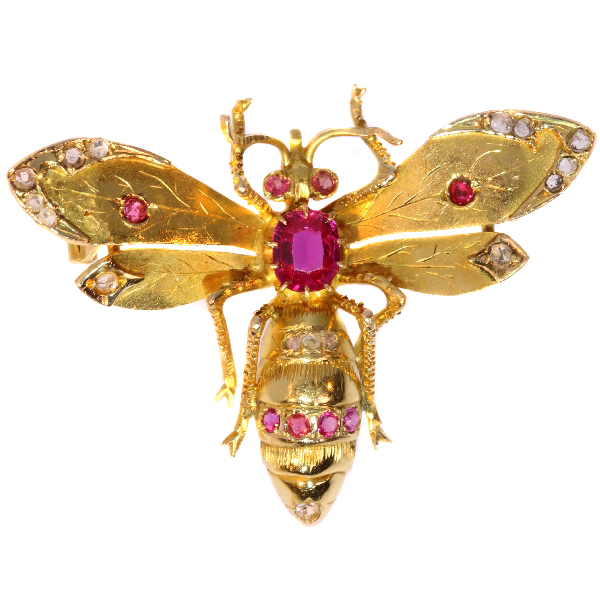We offer layaway, spread payments on the piece of your dreams. Ask us for details. Free insured shipping on all orders !!!
Yellow gold Victorian bee brooch with diamonds and rubies
Antique jewelry object group: brooch
Condition: good condition
- (more info on our condition scale)
Country of origin:
Although it does not carry any legible control marks we believe this to be of French or Belgian origin.
Style:
Victorian - Victorian decorative arts refers to the style of decorative arts during the Victorian era. The Victorian era is known for its eclectic revival and interpretation of historic styles and the introduction of cross-cultural influences from the
middle east and Asia in furniture, fittings, and Interior decoration. Victorian design is widely viewed as having indulged in a regrettable excess of ornament. The Arts and Crafts movement, the aesthetic movement, Anglo-Japanese style, and Art Nouveau
style have their beginnings in the late Victorian era.
- See also: Victorian
or more info on styles
Style specifics:
The Grand Victorian Period - Experts divide the reign of Queen Victoria, also called The Victorian era (1837 - 1901) into three periods of about twenty years each; The Romantic Victorian Period (1837 - 1860), The Grand Victorian Period (1860 - 1880),
and the Late or Aesthetic Victorian Period (1880 - 1901).
We consider this to be of the Grand Victorian Period.
This second Victorian period is famous for its ostentatious pieces set with pearls and diamonds (from South Africa). From ca. 1850 wealthy English had reported about jewelry from India and Japan, which heavily inspired the jewelers of this period. This
period also corresponds with the death of Queen Victoria's husband King Albert making mourning jewelry (set with heavy dark stones) the type of jewelry specific for this period.
Period: ca. 1880
- (events & facts of this era, poetry of this era,
fashion of this era)
Source of inspiration: Mother Nature
Theme:
Bee - The bee, found in Ancient Near East and Aegean cultures, was believed to be the sacred insect that bridged the natural world to the underworld. Appearing in tomb decorations, Mycenaean tholos tombs were even shaped as beehives. Bee motifs are also
seen in Maya cultures, an example being the Ah-Muzen-Cab, the Bee God, found in Maya ruins, likely designating honey-producing cities (who prized honey as food of the gods).
In ancient Egypt, the bee was an insignia of kingship associated particularly with Lower Egypt, where there may even have been a Bee King in pre-dynastic times. After the unification of Upper and Lower Egypt, this symbol was incorporated in the title
usually preceding the throne name of pharaoh. Honey bees, signifying immortality and resurrection, were royal emblems of the Merovingians, revived by Napoleon. The bee is also the heraldic emblem of the Barberini.
In heraldry, the bee symbolizes diligence and indefatigable effort. Someone is said to be busy as a bee when he or she works tirelessly and regardless of schedules or breaks. (from:
Wikipedia)
Material: 18K yellow gold
- (more info on precious metals)
Extra information:
Bees - Bees figure prominently in mythology and have been used by political theorists as a model for human society.
Despite the honey bee's painful sting and the stereotype of insects as pests, bees are generally held in high regard. This is most likely due to their usefulness as pollinators and as producers of honey, their social nature, and their reputation for
diligence.
In ancient Egypt, the bee was seen to symbolize the lands of Lower Egypt, with the Pharaoh being referred to as "He of Sedge and Bee" (the sedge representing Upper Egypt). (From: Wikipedia)
Diamond(s):
Ten
rose cut diamonds. We do not have the weight of the diamonds which is normal in our trade when it comes to rose cuts.
Precious stones:
Nine
rubies
(colour etc.: rose)
Treatment: Lab-produced using the Verneuil technique. Auguste Victor Louis Verneuil was a French chemist (1856-1913) which was grown in a lab first rubies. He published his results in 1904. Today his technique is still used for many type of gemstones..
Birthstones:
Diamond is the birthstone (or month stone) for April
and ruby for July.
- (more info on birthstones)
More background information on:
victorian,
styles overview,
victorian jewelry,
birthstone,
Hallmarks: No trace.
- (more info on hallmarks)
Dimensions: Width: ± 3,50 cm (1,38 inch) - Height: ± 2,70 cm (1,06 inch)
Weight: 3,90 gram (2,51 dwt)
Reference Nº: 18079-0172
Copyright photography: Adin, fine antique jewelry
jewelry with insects,
yellow gold jewelry,
jewelry with rose cut diamonds,
jewelry with ruby,
jewelry with diamond,
latest acquisitions,
antique jewelry,
estate jewelry,
vintage jewelry or
modern jewelry
Jewelry with birthstones (or month stones) for:
January -
February -
March -
April -
May -
June -
July
August -
September -
October -
November or
December.
Additional information:
jewelry glossary -
wall of fame -
visit us in Antwerp -
subscribe to our mailinglist.
What is antique jewelry? -
What is estate jewelry? -
What is vintage jewelry?




